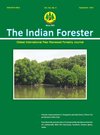Seasonal Variation in the In-vitro Responses of Mature Nodes of Tecomella undulata (SM.) Seem
DOI:
https://doi.org/10.36808/if/2016/v142i9/102523Keywords:
Sterilants, Antioxdient, Aseptic, Callusing, Necrotic.Abstract
Tecomella undulata is a medicinally, ecologically and economically important timber species of hot arid regions of India and Pakistan. No methods are available for its vegetative propagation therefore, micropropagation was standardized using explants collected from mature trees. Sterilization and establishment of explants remains the most important step for successful micropropagation. In the present study differences in per cent aseptic (72.0 to 37.33) and necrotic (25.33 to 4.0) cultures as well as morphogenic response were observed when explants were collected in different months from mature trees of T. undulata. Per cent bud break (72.0) as well as number of shoots induced (3.04) was maximum in the month of April while explants collected during winter months (November- February) showed poor response. Callusing on explants was maximum during autumn months and decreased in explants collected during spring season. Antioxidants namely ascorbic acid (50.0 mg/l), citric acid (25.0 mg/l) and arginine (25.0 mg/l) when added to the establishment media (MS + 10μM BAP) reduced extent of callusing. Induced shoots were successfully multiplied on SH medium supplemented with 5.0μM each of BAP and Kinetin while rooting was induced on 10μM IBA supplemented SH medium followed by hardening and acclimatization of rooted shoots.References
Aghdaei M., Salehi H. and Sarmast M.K. (2012). Effect of silver nanoparticles on Tecomella undulata (Roxb.) Seem micropropgation. Advances in Horticulture science. 26: 21-24.
Amin M.N. and Jaiswal V.S. (1987). Rapid clonal propagation of guava through shoot proliferation on nodal explants of mature trees. Plant cell tissue org cult., 9:235-243.
Amin M.N. and Jaiswal V.S. (1993). In vitro response of apical bud explants from mature trees of jackfruit (Artocarpus heterophyllus). Plant cell tissue org cult., 33: 59-65.
Arya H.C. and Shekhawat N.S. (1986). Clonal multiplication of tree species in Thar Desert through tissue culture. For Ecol Manag., 16: 201–208.
Arya I.D., Arya S., Kalia S., Kalia R. K. and Sharma S.K. (2005). Seasonal variation in the in vitro response of nodal explants of Dalbergia Sissoo Roxb. Ann For., 13: 258-261.
Bhansali R.R. (1993). Bud culture for shoot multiplication and plantlet formation of Tecomella undulata (Rohida) a wood tree of arid zone. Trop. Sci., 33:1–8.
Bhatt I.D. and Dhar U. (2005). Factors controlling micropropagation of Myrica esculenta buch.Ham. ex D. Don: a high value wild edible of Kumaun Himalaya. African J. Biotechnology, 3: 534-540.
Datta S.K., Datta P.C. and Pramanik T. (1983). In vitro clonal multiplication of mature trees of Dalbergia sissoo Roxb. Plant cell tissue org cult., 2: 15-20.
Enjalric F., CarronM.P. and Lardet L. (1988). Contamination of primary cultures in tropical areas. The case of Hevea brasiliensis. Acta Hort., 225: 57-65.
Gupta P.K., Mascarehans A.L. and Jagannathan V. (1981). Tissue culture of forest trees. Clonal propagation of mature trees of Eucalyptus citriodoraHook by tissue culture. Plant Sci Lett., 20: 195-199.
Gupta P.K., Nadgir A.L., Mascarehans A.L. and Jagannathan V. (1980). Tissue culture of forest trees. Clonal propagation of Tectona grandis L. (teak) by tissue culture. Plant Sci Lett., 17: 259-268.
Kalia R.K., Arya S., Kalia S. and Arya I.D. (2007). Plantlet regeneration from fascicular buds on seedling explants of Pinus roxburghii. Biologia Plantarum, 51:653-659.
Kalia R.K., Rai M.K., Sharma R. and Bhatt R.K. (2014). Understanding Tecomella undulata: An endangered pharmaceutically important timber species of hot arid regions. Genet Resour. Crop Evol., 61: 1397-1421.
Kalia S., Kalia R.K. and Sharma S.K. (2004). Effect of season on aseptic culture establishment from nodal explants of mature trees of Dalbergia sissoo Roxb. Indian J. Soil Cons., 32: 164-166.
Kumari S. and Singh N. (2012). Multiplication of desert teak Tecomella undulata under in vitro conditions. J. Trop. Med. Plant,13: 137-143.
Murashige T. and Skoog F.A. (1962). Revised medium for rapid growth and bioassays with tobacco tissue cultures. Physiol. Plant,15:473–497.
Rai M.K., Asthana P., Jaiswal V.S. and Jaiswal U. (2010). Biotechnological advances in guava (Psidium guajava L.): Recent developments and prospects for further research. Trees – Structure and Function. 24:1–12.
Rathore T.S., Singh R.P. and Shekhawat N.S. (1991). Clonal propagation of desert tree (Tecomella undulata) through tissue culture. Plant Sci., 79: 217–222.
Ravishankar B. and Shukla V.J. (2007). Indian systems of medicine: a brief profile. Afr. J. Trad. CAM., 4: 319 – 337.
Robinson R., Kumari B. and Beniwal V.S. (2005). In vitro shoot multiplication of Tecomella undulata (SM.) Seem. - an endangered tree species. Indian J. Plant Physiol., 10: 372-376.
Tyagi H. and Tomar U.K. (2013). Factors affecting in vitro shoot proliferation and rooting of mature Tecomella undulata (Sm.) Seem Tree. Research in Plant Sciences, 1: 38-44.
Downloads
Downloads
Published
How to Cite
Issue
Section
License
Unless otherwise stated, copyright or similar rights in all materials presented on the site, including graphical images, are owned by Indian Forester.





